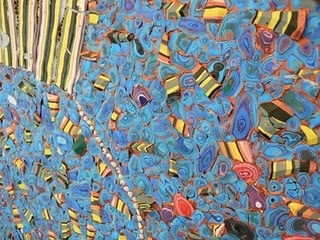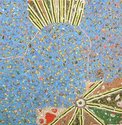John Hurrell – 9 July, 2009
This current Wealleans' exhibition shows once more how technically and formally innovative this artist can be - reinventing sculpture; reimagining painting.
Rohan Wealleans is one of those artists whose best work inhabits the space between sculpture and painting, and between narrative and abstraction. He gets into trouble with freestanding sculpture or easy narratives using animal life, tribal figures or women’s orifices. The great work comes out of ambiguity; stuff that is vague, nebulous, sculptural and wall based.
This current Wealleans exhibition shows once more how technically and formally innovative this artist can be - reinventing sculpture; reimagining painting.
Once it was the intricate marbling revealed when rubbery layers of stratified paint applied over bits of furniture were sliced into, peeled back, exposed and pinned down. Then it was carved into angular formations of latexy acrylic, crystalline prismatic growths on a geological paint surface. Now he has blended the two: angular prismatic offcuts are embedded in deep veins of rubberfied paint to be re-exposed when like the large ball in this show, the form is bisected and pulled apart.
Other things are happening as well, especially with the works on paper - a material out of which he has made great finned/open-book page formations in the past, wildly trippy versions of mid-career Don Peebles with none of the puritanical (though still compelling) austerity.
The works on paper in this show are of two types. One is of large, pale glued on pipi-shaped slices, each one ringed with concentrically diminishing fine-lined contours. The other is of butted together clusters of encrusted coloured pimples, hundreds of little pointed knobs that seem to be the start of small stalagmites - all glued to the paper.
The paintings also are of two types. One is of bits of encrusted or carved paint (or stratified strips) glued on to heavy denim so they look a bit like those plaster walls (or concrete floors) with pieces of smashed china or tiles embedded in them, or Schnabel plate paintings. They look folk-arty, as Wealleans’ work sometimes does, like something you’d find at a church fair. They have an amateurish crafty look about them, as if made by an eccentric aunt to be forgotten and later discovered in a dusty attic. They also look like Licorice Allsorts shoved into the rich icing of a cake.
Wealleans’ other painting type seems a sly joke about John Reynolds and his use of small canvases en masse in Clouds to create an installation. Wealleans’ Silver Lining version has six hundred small stretchers, each one a mini-painting of glued-on chunks of solid acrylic. They are very varied and the work seems not to necessarily need a ‘shaped hang’ like a Tony Cragg coloured plastic ‘painting’ - as shown here. All six hundred acrylic assemblages in a long row at eye height could just as easily hold your attention. Maybe more.
As I indicated earlier, my favourite Wealleans are the more sculptural ‘paintings’ (or painted ‘sculptures’) that really project out from the wall. I like their lumpy pachyderms with strange warty gall-like or testicular growths. This current work, like that of the past few years, is fiddlier. Nevertheless this is an excellent, high-energy, characteristically inventive Wealleans exhibition. Not to be missed.
John Hurrell






 Two Rooms presents a program of residencies and projects
Two Rooms presents a program of residencies and projects Advertising in this column
Advertising in this column



This Discussion has 0 comments.
Comment
Participate
Register to Participate.
Sign in
Sign in to an existing account.